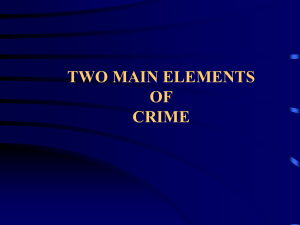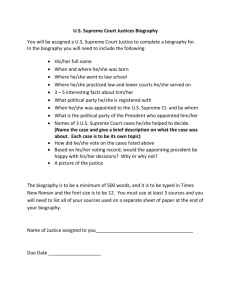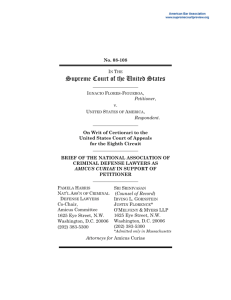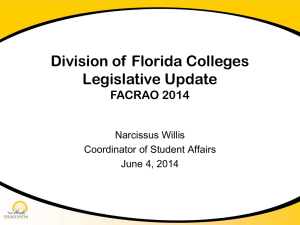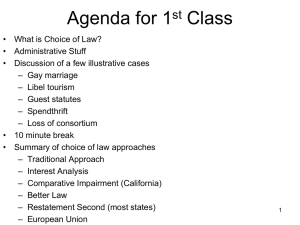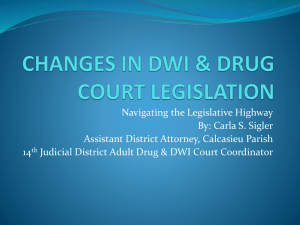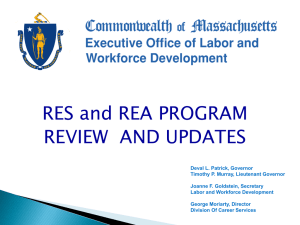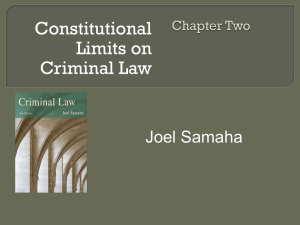Statutory Construction in Federal Criminal Cases
advertisement
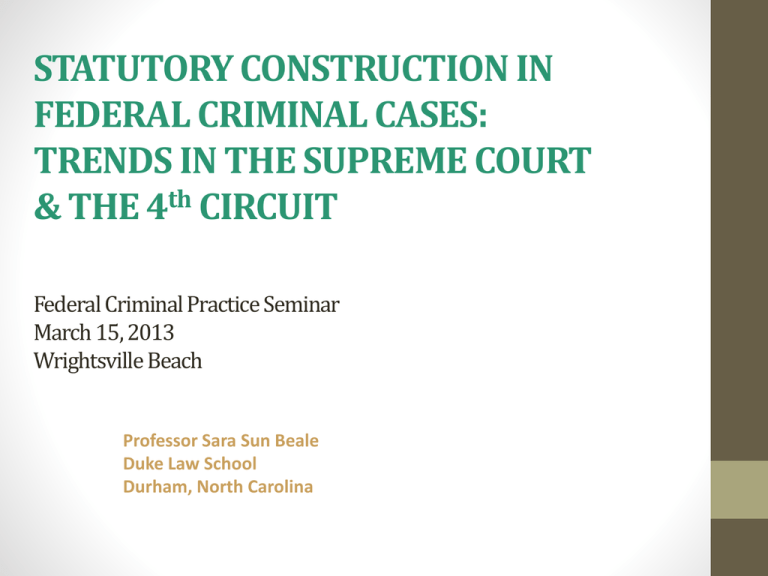
STATUTORY CONSTRUCTION IN FEDERAL CRIMINAL CASES: TRENDS IN THE SUPREME COURT & THE 4th CIRCUIT Federal Criminal Practice Seminar March 15, 2013 Wrightsville Beach Professor Sara Sun Beale Duke Law School Durham, North Carolina Theories of statutory interpretation & the judge’s role •Beginning in the 1980s, judges and scholars developed the approach referred to as “new textualism.” Textualism •The new textualists generally reject the idea that courts should seek to divine Congress’s purpose, focusing instead on the language that Congress enacted. Textualism •Justice Scalia is the most wellknown advocate of textualism. •He argues his position in his book A MATTER OF INTERPRETATION. Justice Scalia’s textualism • Justice Scalia argues that a text should be construed “reasonably” – not strictly or leniently – to contain all that it fairly means. Justice Scalia’s textualism •Legislative history is unreliable: • Generally there is no true legislative intent, and • Reliance on legislative history creates an incentive for the creation of false or contrived evidence of non-existent intent. Justice Scalia’s textualism • Even if constitutional interpretation is a search for the original intent of the Constitution, in the case of statutes we don’t care about Congress’s intent – just what the words they enacted mean. Justice Scalia’s textualism •The words of a statute must be interpreted in context. •To put statutory language in context, there are sources to which courts may look. Justice Scalia’s textualism • Sources courts may consult in putting the statutory language into context include: • dictionaries • canons of interpretation, and • history. Purposivism •Purposivism is at the other end of the methodological spectrum from textualism. •It posits a much broader role for the interpreting judge. Purposivism •Justice Breyer is the most wellknown advocate for this approach. •He argues his views in his books ACTIVE LIBERTY and MAKING DEMOCRACY WORK. Justice Breyer’s Purposivism An “overly literal reading” can stand in the way of “help[ing] statutes match their means to their overall public policy objectives,” which in turn translates the popular will into sound public policy. Justice Breyer’s Purposivism • A wide range of interpretative tools help judges effectuate the will of the legislature. Breyer’s Interpretive Tools • • • • • • Text History Tradition Precedent Purposes Consequences Justice Breyer’s Purposivism One hallmark of Justice Breyer’s method is his focus on what scholars have called his pragmatic consequentialism. Economic Theories of Statutory Interpretation • Scholars have suggested that considering ex ante and ex post decision-making is helpful. • Hard cases can invite ex post decisionmaking that imposes excessive costs on society. Economic Theories of Statutory Interpretation • Courts act should as faithful agents reconstructing the legislature’s ex ante legislative bargains, because this gives both members of Congress and interest groups confidence that their statutory bargains will be respected and enforced. Economic Theories of Statutory Interpretation • Even if you accept the analogy to enforcing a contract, this does not necessarily determine what counts as the best evidence of a bargain. • Should one consult the legislative history or just the statutory text? How have these methodological debates played out in criminal cases? How have these methodological debates played out in criminal cases? • Are criminal cases different? • What about, for example, the rule of lenity? U.S. v. Santos (2007) • 18 U.S.C. § 1956 prohibits the use of “proceeds” of criminal acts for various purposes. • The question before the Court was whether “proceeds” are gross receipts or net profits. Scalia’s plurality in Santos • No textual definition of “proceeds” and dictionaries show both meanings are accepted in ordinary usage. • “Proceeds” has acquired no common meaning in the Federal Criminal Code. Scalia’s plurality in Santos • Context gives meaning, and requires analysis of the whole statute. Scalia’s plurality in Santos • Each reference to “proceeds” in § 1956 makes sense with either interpretation. • Under either interpretation, all portions of the statute are coherent, no provisions are redundant, and the statute is not “utterly absurd.” Scalia’s plurality in Santos • Since the statute is ambiguous, the rule of lenity requires it to be construed in the D’s favor. • No one should be subjected to punishment not clearly proscribed, and the rule of lenity puts the weight of inertia on the party that can best induce Congress to speak. Scalia’s plurality in Santos • Speculating about Congress’s purpose would raise the “merger” problem. • If proceeds are gross receipts, nearly every violation of the illegal-lottery statute would be punishable by the much more severe money laundering statute. Scalia’s plurality in Santos • The solutions to the merger problem proposed by other justices have no foundation in the text. • Lenity construes ambiguous statutes in favor of the D, even if that makes it harder for the government to prove its case. Alito’s dissent in Santos • Since proceeds can have two meanings, the Court should look at the context. • Here, the context is use in a money laundering statute. • The leading international money laundering treaty, the Model Act, and 14 state statutes all define proceeds as gross receipts. Alito’s dissent in Santos • Interpreting proceeds as gross receipts best promotes the purposes of money laundering statutes: • Preventing drug traffickers and others from enjoying the fruits of their crimes, and • Preventing the use of dirty money to promote the growth of illegal enterprises. Alito’s dissent in Santos • Interpreting proceeds as net profits produces perverse results: • Immunizes successful criminal enterprises temporarily operating in the red, and • Creates pointless and difficult problems of proof. Alito’s dissent in Santos • The “merger problem” motivates both the plurality and concurrence. But • If there is a problem, it can be addressed at sentencing, and • The problem would arise as a result of the interpretation of another section of the statute not before the Court and would affect only a subset of cases. Breyer’s dissent in Santos • Agrees there is a “merger problem,” but there are better ways to address than interpreting proceeds as profits: • Require the money laundering and predicate offense to be distinct to be punished separately, or • Address the issue through the Sentencing Guidelines. Comparing the approaches • Scalia’s textual approach limited the sources; unlike Alito, Scalia did not consult the treaty, model act, and state laws, nor did he consider what might facilitate the general purpose of the statute. • In the face of acknowledged ambiguity, he applied rule of lenity. Comparing the approaches • Alito consulted a very wide range of sources (all of which he found to favor the government’s interpretation), including the general purposes of the statute. • Justice Breyer concurred in this opinion, which seems consistent with purposivism. Comparing the approaches • Justice Breyer’s separate opinion is distinctive in its emphasis on pragmatic consequentialism. • We know what Congress was trying to do. What’s the best way to get there? • No special emphasis on the text or ruleof-lenity concerns. Favorable Canons • From the defense perspective, the rule of lenity is the most favorable (and most generally applicable) canon of construction. Favorable Canons • Application of the rule of constitutional avoidance (CRS at 21) will also generally narrow the interpretation of a statute (though the statute may then survive a constitutional challenge) Favorable Canons • Ejusdem generis (CRS Report at 10) will also generally benefit the defense, because it tends to limit the interpretation of statutory terms. It instructs that when terms appear in a series, general words are to be read as applying only to other items akin to those specifically enumerated. Favorable Canons • Extraterritorial application is disfavored. Interpretative principles: mens rea when statute silent • Many cases suggest that the courts will read in a mens rea requirement. • Morissette v. U.S. (1952) held that when Congress codified a common law offense it would be presumed to have intended to carry forward the common law mens rea requirement. Interpretative principles: mens rea when statute silent • Staples v. U.S. (1994) recognized the “background rule[]” that requires some mens rea, noting it is the rule not the exception in Anglo-American law. • Strict liability is “disfavored” and some expression of intent, express or implied, is necessary to dispense with mens rea. Interpretative principles: mens rea when statute silent • In Staples, Justice Thomas wrote that the Court has taken “particular care” to avoid dispensing with mens rea when that would criminalize an broad range of apparently innocent conduct (citing Liparota (1985). Interpretative principles: mens rea when statute silent • In Staples, Justice Thomas suggests, but finds it unnecessary to adopt, a per se rule that -• “absent a clear statement from Congress that mens rea is not required, we should not apply the public welfare offense rationale to interpret … any felony offense as dispensing with mens rea.” Interpretation when statute includes a mens rea term • Flores-Figueroa v. U.S. (2009) states another general rule that can be beneficial in a wide range of cases. • The question was whether the mens rea term “knowingly” in the aggravated identity theft statute, 18 U.S.C. § 1028A applied to all elements of the statute. Flores-Figueroa (Breyer) • “In ordinary English, where a transitive verb has an object, listeners in most contexts assume that an adverb (such as knowingly) that modifies the transitive verb tells the listener how the subject performed the whole action, including the object as set forth in the sentence.” Flores-Figueroa (examples) • “If we say someone knowingly ate a sandwich with cheese, we normally assume that the person knew both that he was eating a sandwich and that it contained cheese.” Flores-Figueroa (Breyer) • Courts generally interpret statutes in a manner consistent with ordinary English usage. • “… courts ordinarily read a phrase in a criminal statute that introduces the elements of a crime with the word ‘knowingly’ as applying that word to each element.” Flores-Figueroa (Breyer) • Rejects contrary arguments based on overall text of the statute and legislative history. Flores-Figueroa (Breyer) • Rejects argument that proving knowledge will be too difficult: concerns about “practical enforceability are insufficient to outweigh the clarity of the text.” Flores-Figueroa (Scalia) • Notes disagreement with normative description that mens rea term ordinarily applies to all elements and distinguishes Staples (where no mens rea was stated) from a statutory text that carefully limits mens rea. Flores-Figueroa (Alito) • “It is fair to begin with a general presumption that specified mens rea applies to all the elements of an offense, but … there are instances in which context may well rebut the presumption.” Flores-Figueroa’s value • Seven members of the Court agree that courts should begin with at least a presumption that a stated mens rea term applies to all elements of any statute. • Breyer’s opinion (which garnered 6 votes) seems to go even further than a presumption. The Fourth Circuit • How does it compare to other circuits? • Unfortunately, my research does not permit me to do a close comparison of use of different methods of statutory interpretation, use of canons, etc. Can compare reversal rates • For criminal appeals FY ending 9/30/2012: • National reversal rate : 7.0% • Range 15.8% (7th Circ.) to 1.3% (10th Cir.) • 4th Circuit reversal rate: 6.5% Interpretative method 4th Circuit cases • Would like to acknowledge the work of research assistants Emily May, Logan Starr, and Eric Mattingly (all of the Duke Law class of 2013), who identified and coded the cases in the handout. Interpretative method 4th Circuit cases • Not surprisingly, most opinions at least begin with the text (and many end there). • In about 25% of the cases my research assistants coded, the court relied on a dictionary. Interpretative method 4th Circuit cases • Some opinions go beyond the text to consider purposive elements, i.e., intended effect of the statute (which often involves use of legislative history). Interpretative method 4th Circuit cases • Other opinions (coded as “prudential”) focus on the potential consequences of a proposed interpretation, for example, applying the canon of absurd results.
